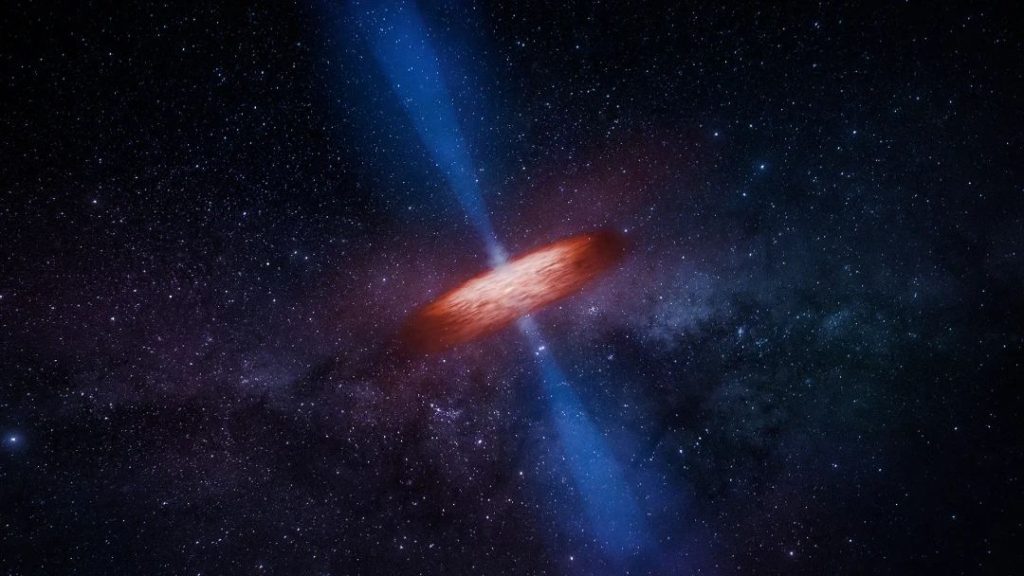Astronomers investigate black hole jets with Event Horizon Telescope – Space.com

“For such a faint and unknown target, we were not sure if we would get any data at all — but the strategy worked.”
When you purchase through links on our site, we may earn an affiliate commission. Here’s how it works.
Astronomers studying elusive supermassive black holes at the hearts of galaxies are intrigued not only by the cosmic behemoths themselves but also by the colossal jets they launch into space at near-light speeds, the biggest of which are known to span millions of light-years. In particular, the physics of what creates and accelerates these jets to near-light speeds has remained murky.A large group of astronomers led by Anne-Kathrin Baczko of the Chalmers University of Technology in Sweden are now confident the Event Horizon Telescope (EHT) — a planet-sized array of eight ground-based radio telescopes forged through international collaboration — is up to the task.In 2017, the team first used EHT telescopes to peer at the dust-obscured heart of a distant galaxy, where black hole jets are formed and accelerated. The galaxy, NGC 1052, resides roughly 60 million light-years away in the constellation Cetus and hosts a supermassive black hole that weighs more than 150 million suns and blasts bipolar jets from its east and west sides, as viewed from Earth.While a promising target for EHT imaging, the galaxy’s heart is “faint, complex and more challenging than all other sources we’ve attempted so far,” Baczko said in a statement. “For such a faint and unknown target, we were not sure if we would get any data at all — but the strategy worked.”The team’s observations revealed that NGC 1052’s black hole region emits bright radio waves at a one-millimeter wavelength. This wavelength region on the electromagnetic spectrum is accessible by EHT in order to create the sharpest possible images, according to a paper the team recently published in the journal Astronomy & Astrophysics.The region shines even brighter at slightly longer wavelengths, however, making it a prime target for forthcoming radio telescopes, such as the next generation Very Large Array in New Mexico or the next generation Event Horizon Telescope, an expanded version of EHT that astronomers hope will capture not just images but also videos of black holes.Meanwhile, the dusty region around the black hole, where jets are generated, was found to be similar in size to the ring around the supermassive black hole M87*, which rose to fame in 2019 when it became the first void to be imaged by the EHT collaboration as a fuzzy orange donut. That means the region is “easily big enough to be imaged with the EHT at full strength,” the researchers say.Breaking space news, the latest updates on rocket launches, skywatching events and more!— Scientists make lab-grown black hole jets— A massive black hole may be ‘waking up’ in a nearby galaxy— Hubble Space Telescope finds closest massive black hole to EarthPrevious observations of NGC 1052’s black hole led by Baczko found the magnetic field around the cosmic abyss is 40,000 times stronger than our planet’s magnetic field — so powerful “that we think it can probably stop material from falling into the black hole,” study co-author Matthias Kadler of the University of Würzburg in Germany said in the statement. “That in turn can help to launch the galaxy’s two jets.”Join our Space Forums to keep talking space on the latest missions, night sky and more! And if you have a news tip, correction or comment, let us know at: community@space.com.Sharmila Kuthunur is a Seattle-based science journalist focusing on astronomy and space exploration. Her work has also appeared in Scientific American, Astronomy and Live Science, among other publications. She has earned a master’s degree in journalism from Northeastern University in Boston. Follow her on BlueSky @skuthunur.bsky.socialStar escapes ravenous supermassive black hole, leaving behind its stellar partnerSmall satellite constellation could reveal black holes like never beforeSpace mysteries: How does the ISS stay in orbit without falling to Earth?Space is part of Future US Inc, an international media group and leading digital publisher. Visit our corporate site.©
Future US, Inc. Full 7th Floor, 130 West 42nd Street,
New York,
NY 10036.






